Writing a good legal blog can be more challenging for some attorneys than others. If you’re new to blogging or you’ve done it in the past and haven’t seen much success with it then you might be wondering if blogging for lawyers is even worth the time and effort.
If your goal is to attract and sign more clients using this marketing strategy, then it certainly can be. We conducted a study several years ago and found that law firm websites that actively blogged generated 15.9 times more traffic than law firms that didn’t blog. We re-conducted that study this year (2022) and found that things haven’t changed. In fact, firms that actively publish content get 16.9 times more traffic than lawyers that didn’t blog. So, yes, blogging can be a powerful part of your law firm’s digital marketing strategy.
So in this article, I’m going to share the 12 most important tips that will show you how to write great legal blog posts and become a better – dare I say it – marketer.
1. Choose Topics Aligned with your Ideal Cases
There are many different legal topics to write about in terms of blogging for lawyers. I’ve seen DIY legal blogs produced and managed by attorneys where they’re writing about things outside of their area of expertise. The recommendation here is simple: only write about legal topics which could directly translate into your firm’s ideal cases.
A family lawyer should only be writing about family law topics. This would include divorce, alimony/spousal support, child custody, child support, modifications, property division, father’s rights and so on. Some family lawyers choose to handle cases that involve domestic violence (DV) while others refer those out or avoid them. So, depending on whether or not you would accept those cases will dictate whether or not you should blog on that legal topic.
Furthermore, don’t hesitate to niche down. Instead of handling all aspects of family law, you could simply handle adoption or father’s rights. This will narrow the list of legal blog topics you can write about, but even such a narrow niche shouldn’t be a problem if you’re in a populated state. You should still be able to find dozens of blog article topic ideas (at minimum) to write about for something like adoption.
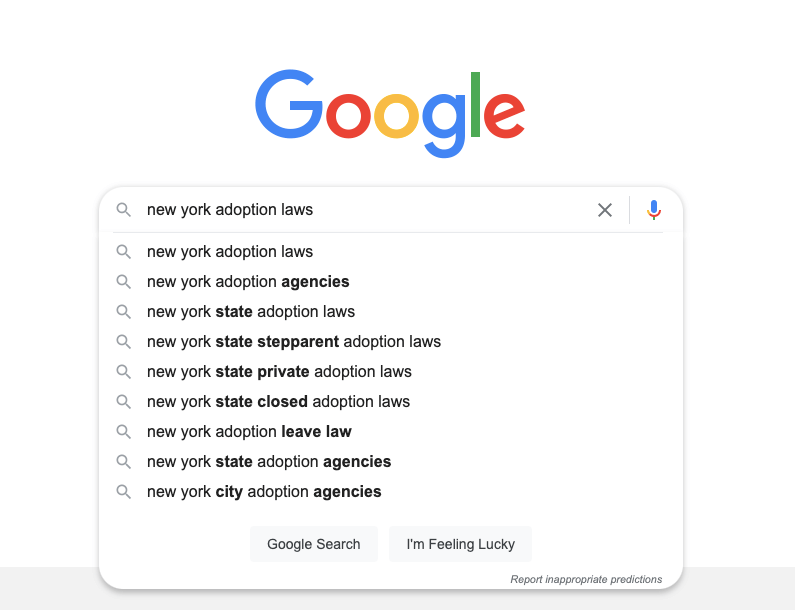
Here’s a quick and easy way to get started generating some topic ideas for your legal blog.
- Go to Google Search.
- Type in a blog topic that fits your ideal cases or primary practice area.
- Write down the autocomplete list of search terms that Google generates.
- Add or remove a keyword, to refine or broaden your list of ideas.
This technique is very simple, but it works great. You don’t have to be a law firm SEO expert to do this. If you spend 20 to 30 minutes doing this, I’m sure you’ll build a list of a dozen legal topics in your area of expertise that you’re keen to blog about.
2. Answer People’s Legal Questions
When it comes to blogging for lawyers with the primary aim of effectively marketing your practice and signing more cases, the key to writing successful legal blogs is to focus on your audience. Instead of writing about topics which interest you, write about topics that interest your target audience (prospective clients). One of the most effective and direct ways to do this is by answering their most common and pressing questions.
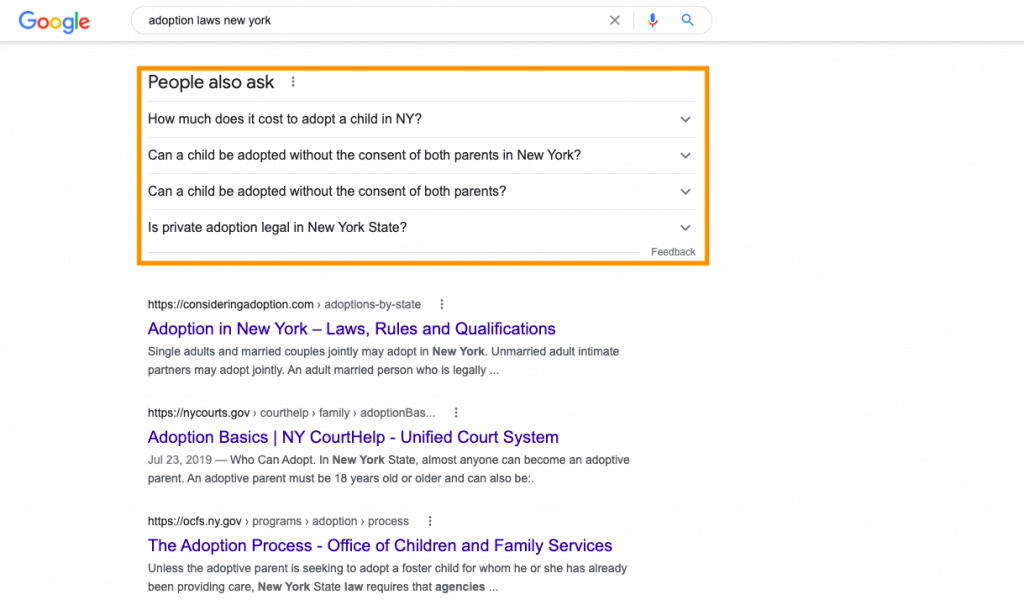
After implementing the practical steps listed in tip #1, Google one of the search terms you wrote down. Continuing with the adoption attorney specialization example, check out the questions Google is telling us people are asking related to this subject (“new york adoption laws” for example). If you click one one of them, Google will load several more related questions, giving you a good number of questions you can answer on this topic.

Another great tool for finding questions related to your legal blog topics that you can write about is AnswerThePublic. This website will help you brainstorm questions you can answer on your law firm’s blog by giving you a visual breakdown of all the types of questions being asked on search engines like Google and Bing.
Once you have your list of questions, any of these questions that can be answered in a couple hundred words or less can be added to another blog post. The questions where it could have lengthy answers (beyond the generic and all too common “it depends” response) likely merit their own standalone article.
3. Write for your Audience (and Prospective Clients)
So far, I’ve shared how important it is to focus on your prospective clients or in other words, your blog’s target audience. When it comes to writing about legal topics, most people are not going to be able to easily understand the technical legal jargon.
Write your legal posts so that they are professional and demonstrate your expertise. And aim to write at about an 8th grade reading level. Check out this article on the Flesch reading ease score. To be clear, I highly recommend including specific legal terminology relevant to your blog posts. Just make sure to explain (or reference a source which explains) the terms and keep those explanations simple. Someone who understands their topic of knowledge best can explain it in the simplest terms.
The easier it is for your readers to understand, the more engaged they will be with your blog and law firm website overall. The more engaged your site’s visitors and blog readers are, the more that will translate into business.
4. Logically Structure your Legal Blogs
One of the biggest mistakes I see being made when it comes to blogging for lawyers is having a well-structured and organized post. When you write a legal blog, it’s not enough for you to share your incredible knowledge of the law. You have to organize it in a logical way. A good research or white paper starts with an abstract, introduction, body sections and ends with key points or a conclusion. A great legal blog post should follow its own, well-planned structure.

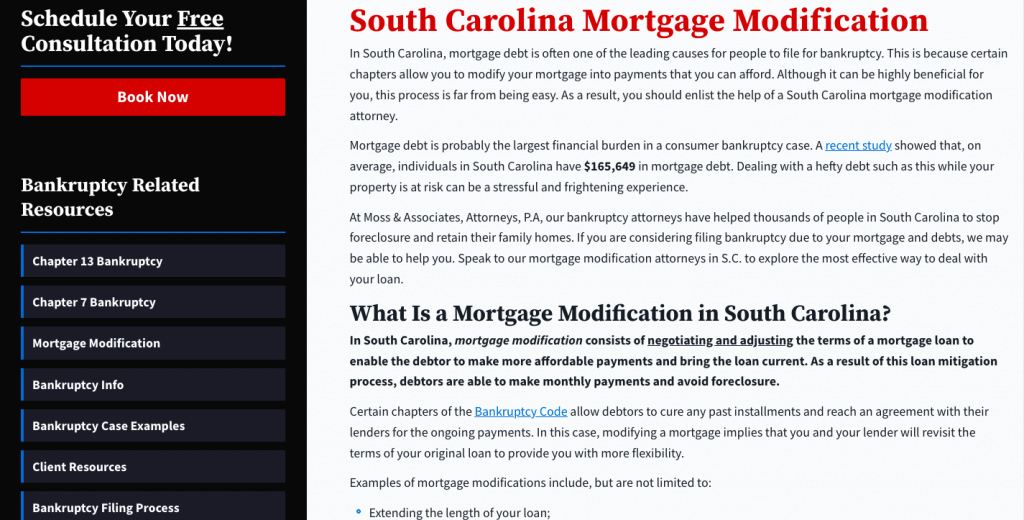
Take these two pages, the “before and after” from a bankruptcy law firm’s website. Look at how much more readable and scannable the article is with clear headings, separating the sub-topics of the blog post. A reader can clearly scan the article to see what they’re going to learn from it or easily find a particular section they are interested in. It also helps them understand the interconnectedness of multiple sub-topics.
Many people re-read entire articles or sections multiple times. Organizing and structuring your posts is a huge benefit to your readers and potential clients.
Here are a few ways you can better organize and structure your legal blogs:
- Add headings and subheadings to organize your sub-topics and related questions
- Nest subheadings (headings 2-6) to further breakdown larger sections of your blogs
- Bold and underline key parts of paragraphs and sentences
- Add an introduction and conclusion (or key points/takeaways) your posts
- Link to other articles on related topics or legal terminology for readers to learn more
5. Do Keyword Research for Each Blog Post
Many times the main objective of blogging for lawyers is to have your legal articles show up in the Google search results. If that’s your goal, then keyword research is a critical part of writing an effective legal blog.
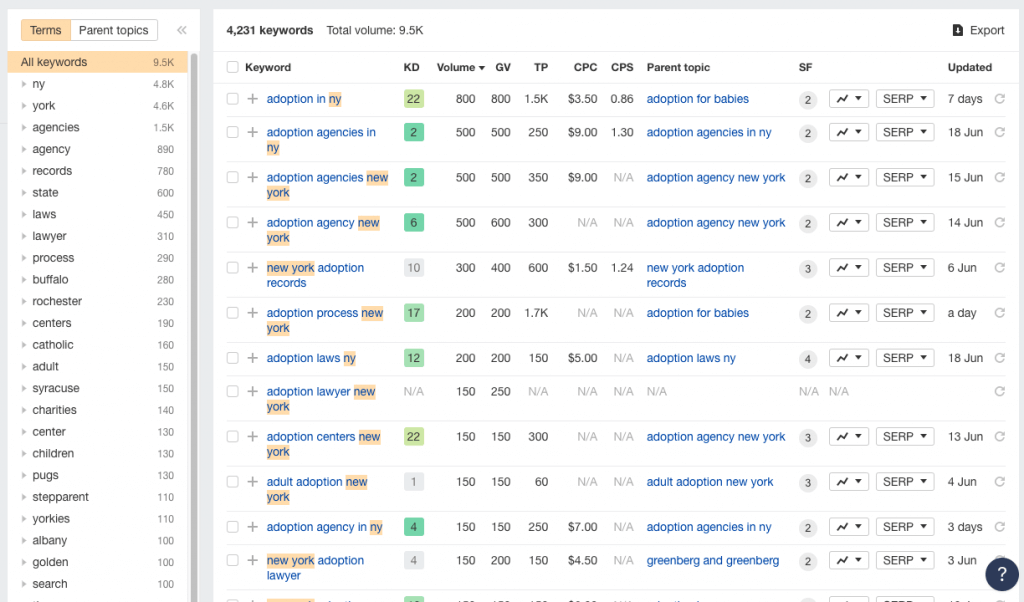
There are many tools that you can use to do keyword research. One of our main tools for doing keyword research for law firm SEO at ZLM is ahrefs.com. As you can see from the screenshot above, within 30 seconds I’ve got a list of thousands of keywords related to adoption in New York to prune through.
When going through the list of keywords, I am primarily bucketing keywords into one of three groups:
- Related to the legal blog topic to write
- Good keywords for future blogs to consider writing
- Unrelated keywords
In the image above, you can see that there are keywords that would fall under each of these groups.
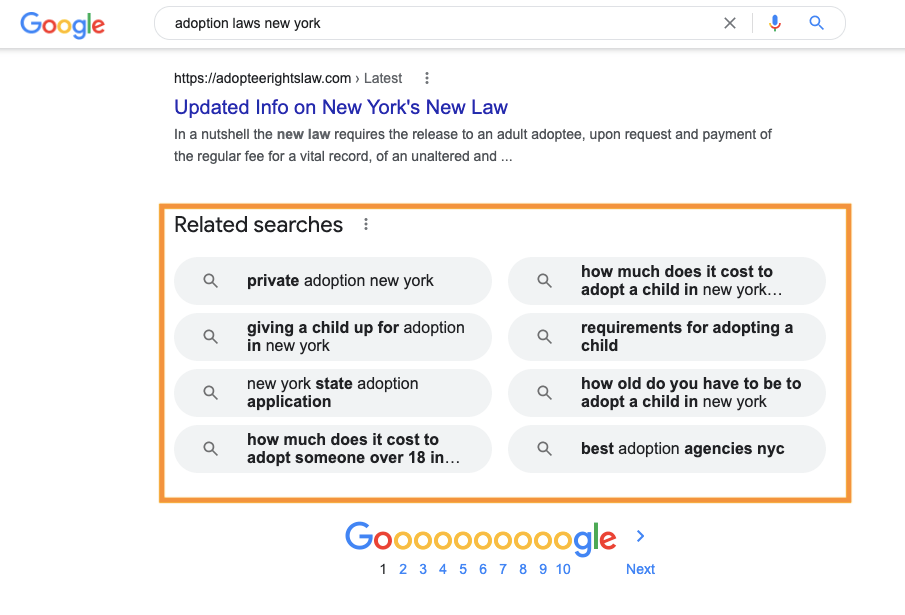
If you’re new to blogging for your law firm, then I suggest sticking with some basic and free keyword research tools. The simplest tool you can use is Google. You can get excellent related keyword ideas from Google’s autocomplete suggestions (in the search bar), the “People also ask” section and the “Related Searches” at the bottom of the results page.
6. Optimize for SEO
Keyword research is a critical part of blogging for lawyers and making sure your legal blogs rank well in search engines. Once you’ve written your legal blogs and are about to publish, it’s time to optimize your articles to rank high in search engine results. While law firm SEO is comprehensive and there are different components to a well-executed SEO campaign (on-page, technical, off-site) you can do a lot by taking a few extra minutes to do some on-page optimizations yourself.
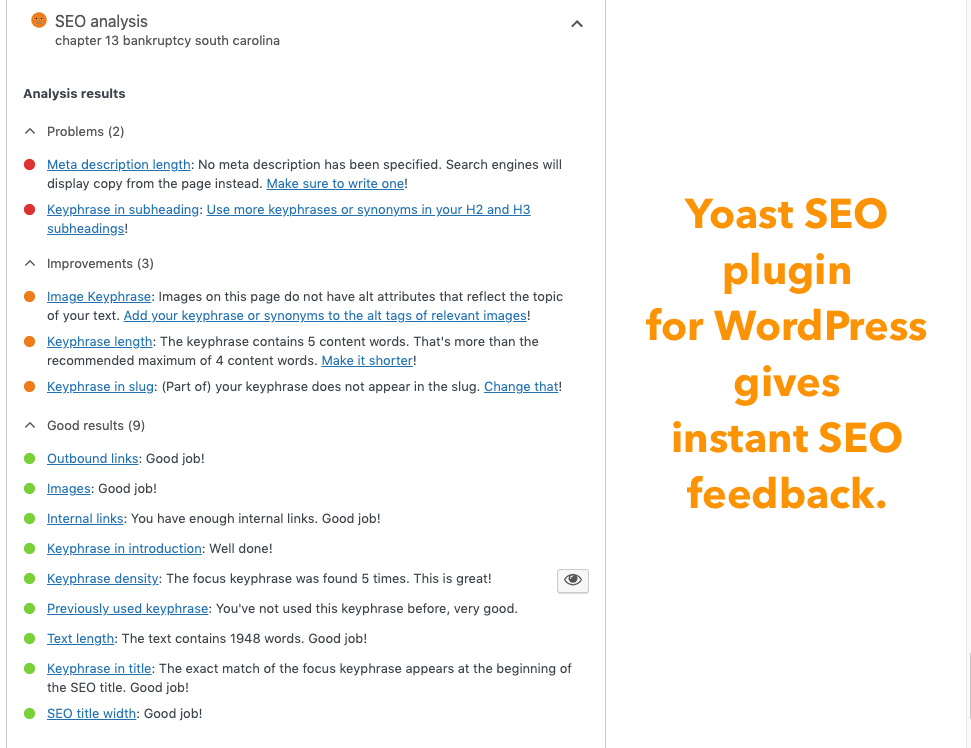
If you’re using WordPress, you can add a plugin like Yoast (shown above), All in One SEO, or RankMath to give you guidance on what you’re doing well and the things on which you can improve.
Here are the on-page SEO tasks you can do to optimize your blog posts:
- Optimize the URL for your main keyword or topic (shorter is better)
- Write a meta description for each blog post
- Use the main keyword in your Title tag and H1 (the article’s main heading)
- Include your keywords in the subheadings (H2 to H6)
- Add the keyword naturally throughout your content
- Take the time to properly structure your legal blogs (Tip #4)
- Make sure to write your posts to be easily understood by your target audience (Tip #3)
- Bold and underline important phrases and sentences in your articles
- Add a table of contents at the top of your longer articles (over 1,200 words)
Once you’ve done the on-page SEO and published, do a final check by visiting your blog and manually inspecting it. Make sure that everything is correct, looks professional and is free of typos.
7. Pitch your Legal Services When Natural to Potential Clients
For most, the purpose of writing blogs for your law firm is to generate new business. It’s completely normal to include call-to-actions (CTAs) in your blog posts and articles to get more phone calls and inquiries. Afterall, blogging for lawyers is an effective form of content marketing and the end goal of content marketing is to market your legal services.
There are many places to add a CTA to pitch your legal services. The most common and the one we usually use for every law firm we work with is at the end of the blog content. As you can see from the image above, it’s as simple as adding an additional section at the bottom of the post. In fact it looks like it’s just part of the rest of the article.
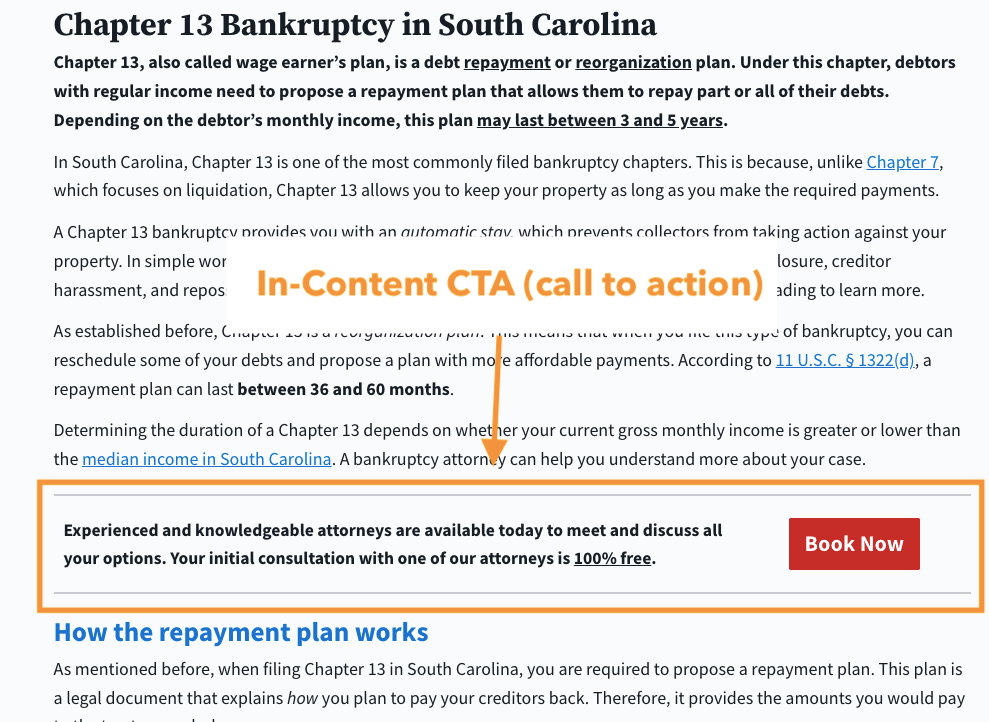
You also have the option to add other calls-to-action in the middle of your content (shown above). You can place these anywhere in your articles; in the middle or bottom of a particular section in your blog post. If you want to add in-content pitches for your services, place those CTAs tactically.
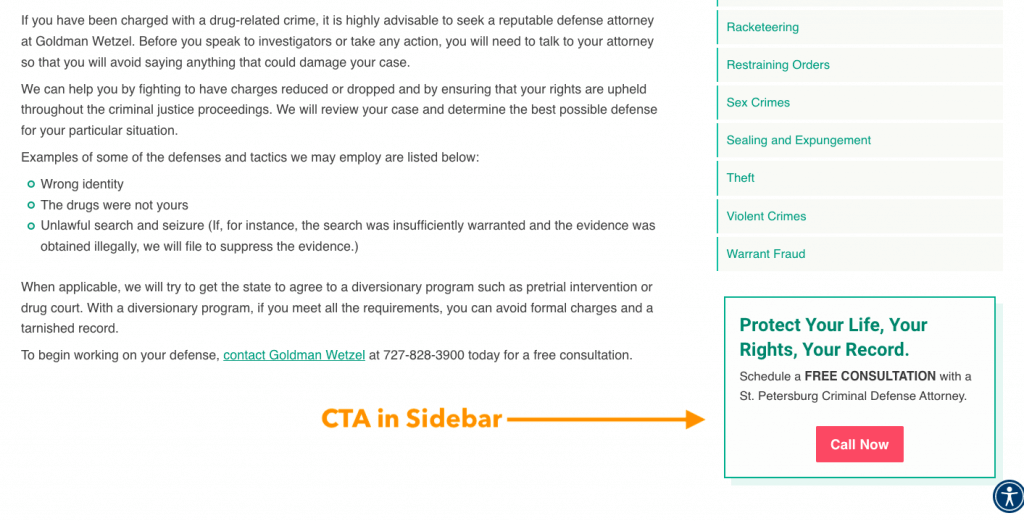
Finally, you can always add a generic sidebar call-to-action which displays on all of your blog posts.
As a general rule of thumb, you can dedicate 10-15% of the content in your blog posts to be topically-relevant sales copy and CTAs. So in a 1,000 word article you can have 100 words of call-to-actions and no more than 150 words. That ensures that the article is high-quality and you can still promote your services.
8. Write Clear and Compelling Headings
Your headings should be clear, concise and captivating. They should explain exactly what the visitor will learn from the article or section for which the heading is written. Often if you keep your section headings informational, you can leave it up to the reader to choose whether that information is relevant to them or not.
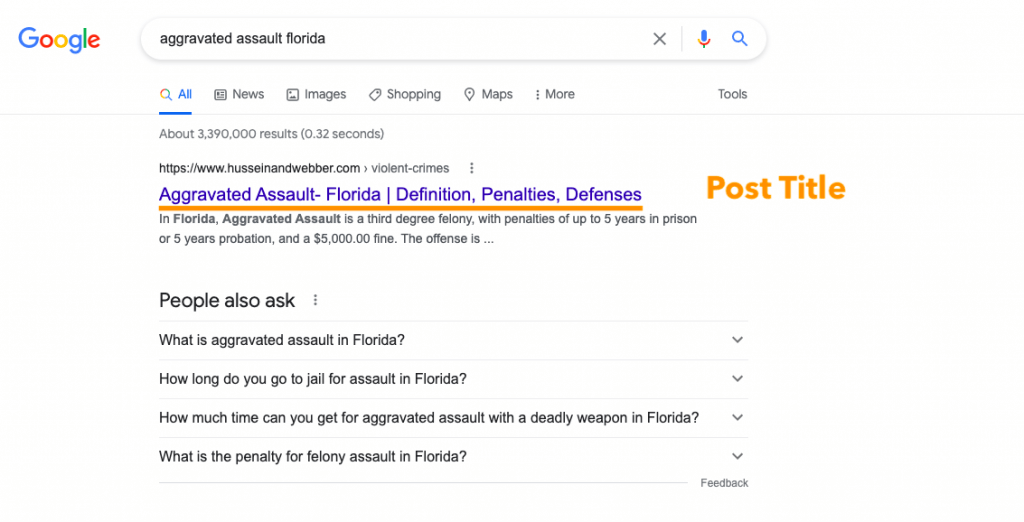
For each blog post’s main title, you want to make the headings as captivating as possible. This way it stands out from other articles in search results. The example above shows how the legal blog in first position for the search term has a clear and yet captivating title for the article and it includes the main keyword.
9. Add Visual Aids
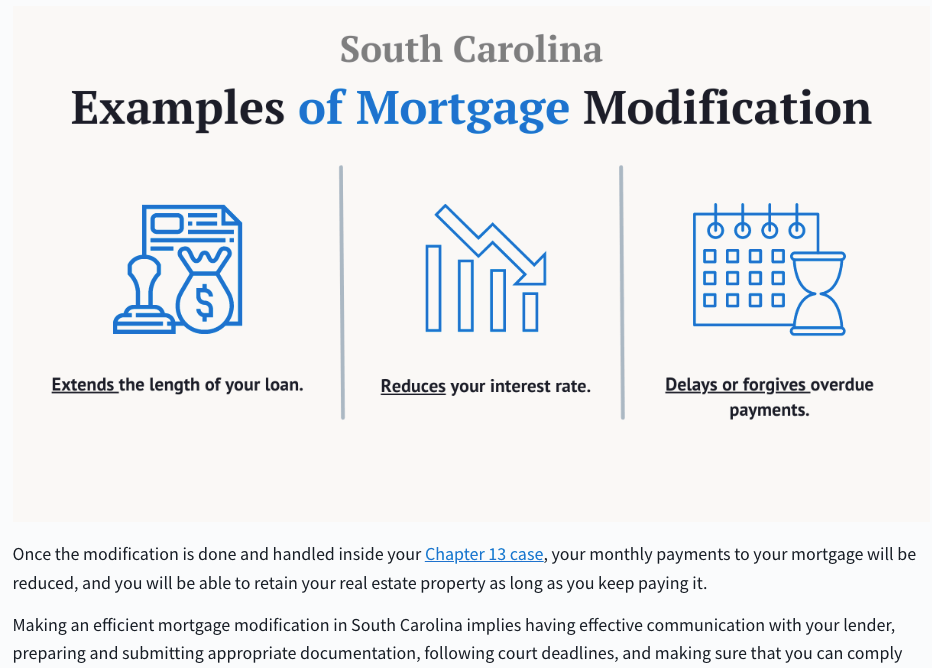
A picture is worth a thousand words. So, anytime where you can enhance your blogs with a visual element, do so. This can be in the form of images, tables, graphics or even videos. We particularly like graphics.

Visual aids benefit your legal blogs both from SEO and content marketing perspectives, but they’re also a big benefit to the reader. The graphic above for instance, clearly shows the visual difference between assault and battery.
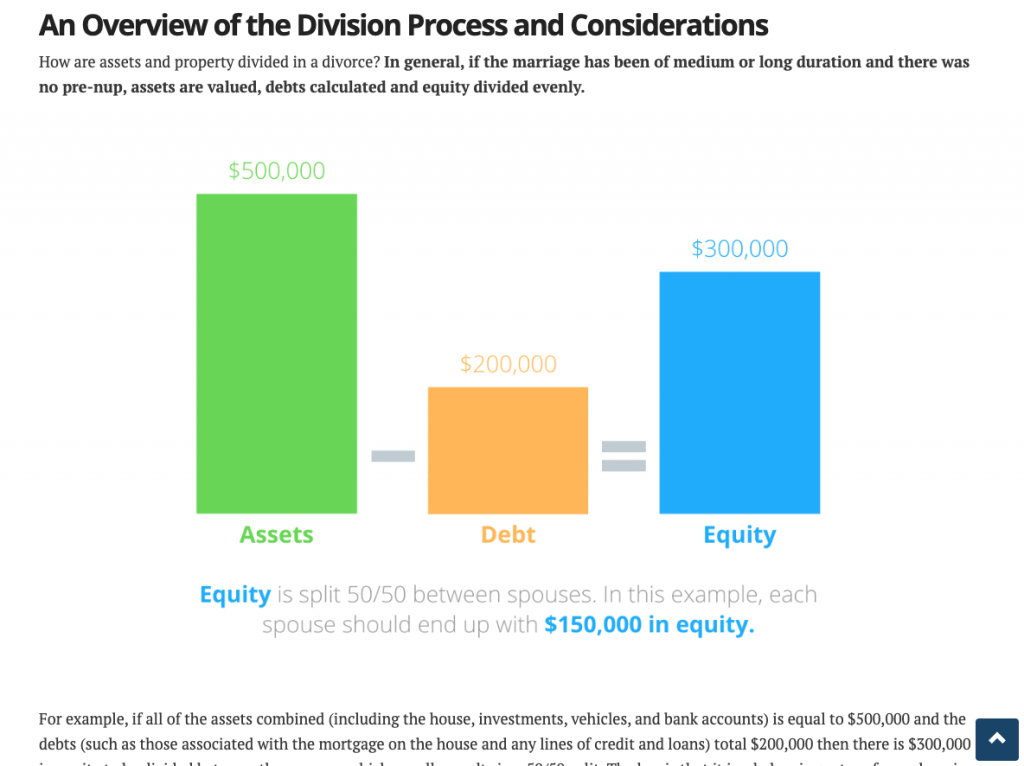
Sometimes, graphics or tables can be useful for explaining concepts that involve numbers or math. It can be difficult for readers to grasp a concept like division of property if all they have are the written words. The graphic showing how property is divided in a divorce supports the blog post and provides a much more valuable resource for potential legal clients.
It’s understandable that this might be considered to be an additional blogging skill for lawyers, but it makes a significant difference and will set you apart from the majority of other attorneys that are writing blogs.
10. Add Examples and Case Law
Your law firm’s blogging strategy should focus on providing your audience with the legal information they’re looking for. Many times, your blog articles can include cases that have gone to court to support your content.
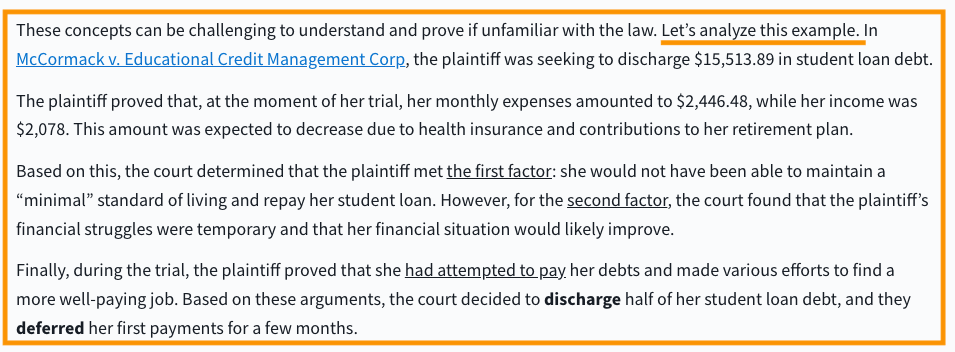
These examples can create a bridge between the contents of your legal blogs (the theoretical, at least from the client’s viewpoint) to their potential case (the applicability). You can make any arguments which you present in your legal blogs stronger by including summarized case material.
We find that many lawyers that take a purely DIY approach to blogging tend to write about case law. The most valuable content, from the perspective of our law firm marketing agency, is that which focuses on delivering what the audience is looking or searching for. When you combine this with case law or realistic examples, you make the content more valuable and very unique compared to the competition.
11. Include Links to Primary Sources & Statistics
Attorneys love to cite things. Yet, when it comes to their blog posts, many seem to lack the proper citations. I’m not talking about referencing sources in APA or Chicago format. Hyperlinking is fine. It’s more the sources that these legal blogs reference. The majority of the time, your firm’s articles should reference federal or state legislature websites, the state’s courts site or similar.
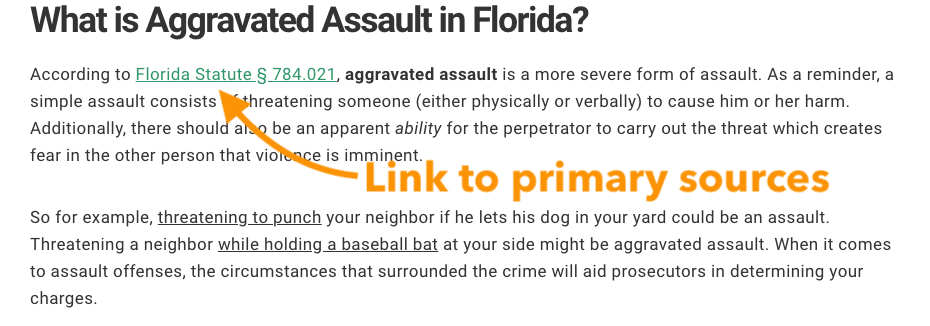
Whenever mentioning important facts or statistics, make sure to link to the primary sources where the law, information or data resides. Occasionally, we create statistically-intensive web content for law firms (it has its purposes). When we do this, we analyze the data and transform it to reveal interesting facts related to the firm’s primary practice area. This analysis and transformation is the value-add that makes the statistical content interesting for marketing purposes. All the same, the raw data must still be properly referenced and linked.
12. Write Fewer Articles of Higher Quality
One of the keys to growing your audience (and ultimately your billables) through blogging for lawyers is to focus on producing high-quality legal content. If your site has many thin blog posts of low value to potential clients, search engines (e.g. Google) and other marketing platforms, then don’t expect much.
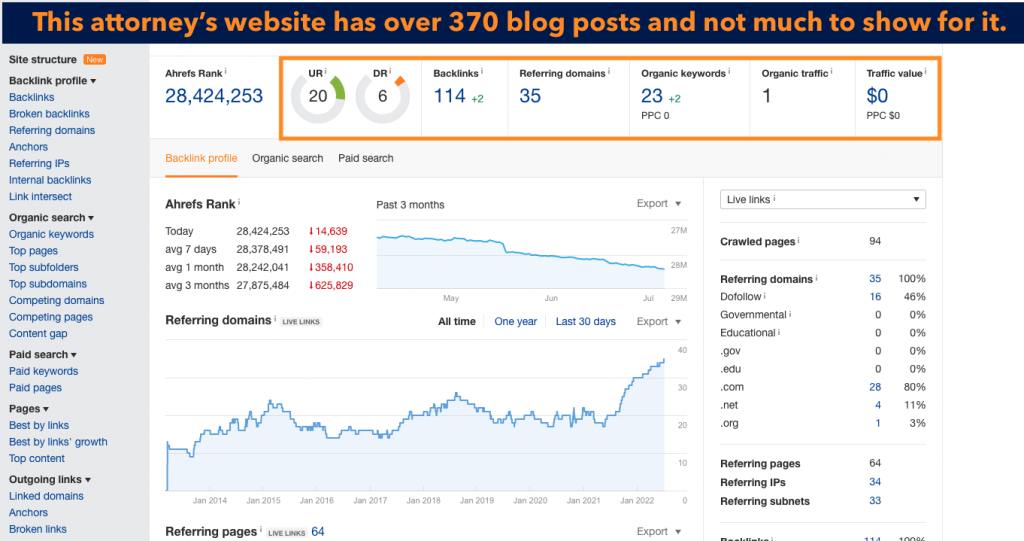
Take the organic traffic and keyword stats for the website above, for instance. This solo practitioner essentially does the opposite of every tip listed here. The site contains 377 blog posts, most of the articles are much less than 500 words and are legal topics he’s interested in rather than what his prospective clients or even referral sources would be interested in. As a result, his entire site, including all 370+ legal blogs, rank for a grand total of 23 keywords which are estimated to generate 1 organic search visitor per month.

On the other hand, let’s take a look at a client that we’ve been working with for a while (see image of their site’s traffic stats directly above). We took their organic search traffic from approximately 1,400 visitors per month and increased it by 14.2 times (similar increases were seen in keywords and traffic value as shown in the image).
How did we do this?
We actually shrank the size of their website’s blog. We put their site on a diet by culling 40% of their legal blog content and improving the quality of the remaining 60% of blog articles. They now receive far more leads and phone calls as a result (with higher quality). It might sound counterintuitive, but writing fewer blogs of higher quality can make a significant difference.
Final Advice on How to Write a Good Legal Blog
You’ve now learned the 12 blogging for lawyers tips that I would give to myself if I were starting a legal blogging or law firm marketing career all over again. Some of these tips sound simple and obvious while others offer more technical knowledge.
I’ll leave you with several pieces of advice to help you write better blogs for your law firm:
- Use these tips as a checklist: Feel free to write these tips down and use them as a checklist anytime you write a new blog post on a legal topic. Making sure you have all twelve items covered will help you practice, memorize and internalize these points until you have enough experience.
- Practice the basics: If you focus on mastering the basics in any field, whether it’s a hobby you have, a particular skill or the cases you work on, yes there are things you have to do differently now and again. But, you have realized that “wash, rinse and repeat” gets you 95% of the way there. By following these tips every time you write an article on your firm’s blog, you’ll have a solid foundation of the skills needed in no time.
Not enough time to blog yourself?
Blogging for lawyers is a phenomenal way to market a law firm and generate more cases in your primary practice area(s). But, it’s time intensive, requires focus and practice. It will also take time and consistent input to generate a predictable stream of results.
At Zahavian Legal Marketing, blogging and legal content writing is our bread and butter. It’s common for us to 2-3x a law firm’s leads in 12 months. We’ve also grown new sites from 0 to over 5,000 daily visitors (yes, daily visitors) just from blogging. We customize our law firm marketing strategy to whether you want your fair share of cases or you want to completely dominate your market. Book a call with us today to see how we can help your firm make it rain.


